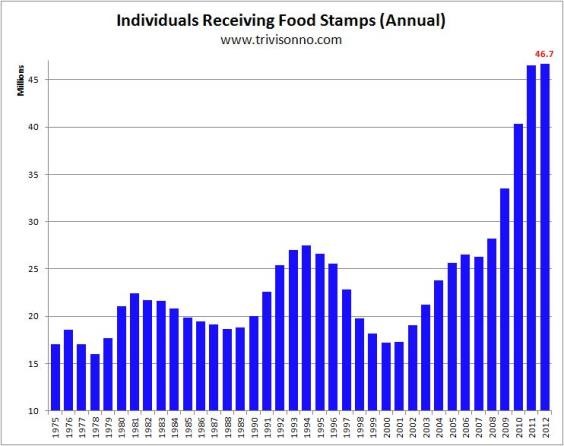A 20-year old food-stamp requirement that was waived during the Great Recession has been reinstated by more than 40 states in an effort to curb spending. As a result, the benefit that serves the poor and unemployed has begun to eliminate hundreds of thousands of people from the rolls just within the past three months.
The food stamp program has been steadily shrinking from its peak of more than 46 million beneficiaries – or nearly one in seven Americans. As the economy improved and congressional lawmakers and state officials pressed to cull the rolls, about 3.1 million fewer Americans received food subsidies in January 2016 than in January 2013, according to government figures.
Related: Food Stamp Use Is Falling, and the GOP Wants to Cut It Even More
Now, as the country approaches full employment, many states have reinstated a controversial 1990’s era requirement that able-bodied single adults with no children find a job within three months of receiving benefits and work an average of 20 hours a week in order to stay in the program. About 20 of the 40 states that reinstated that requirement announced their decisions in January.
In the wake of those actions, the Department of Agriculture recently reported that the number of food stamp recipients dropped by 773,000 in April alone. That was the largest one-month decline in the federal and state supplemental nutrition program since temporary benefits for Hurricane Katrina victims ended in 2005, according to experts.
An analysis by the Center on Budget and Policy Priorities (CBPP) says 45 states in all show some declines in program participation in April, including a majority that ordered the reinstatement of the work requirement.
Related: $74 Billion Food Stamp Program in Budget Crosshairs
“Eight of the ten states with the largest percentage caseload drop that month implemented the time limit in January, including Florida, Missouri, Alabama, and Arkansas,” the analysis stated. “Caseloads fell by 2.8 percent in the states that began cutting people off [food stamps] in April due to time limits, while falling 0.8 percent in the other states.”
Other states that re-imposed the work requirement in January include New York, Pennsylvania, West Virginia, Massachusetts, Connecticut, New Jersey, North Carolina and South Carolina.
The current total caseload of 43.6 million people is at the lowest point since 2010, according to CBPP. The liberal-leaning policy research organization said the Agriculture Department data for April is consistent with its own estimate that more than 500,000 people will lose benefits in 2016 due to the time limit for finding work.
The food stamp program, formally known as the Supplemental Nutrition Assistance Program (SNAP), is an anti-poverty program that provides low-income families and adults with an average of $192 a month to purchase groceries and other necessities. College students who work 20 hours a week are also eligible.
The roughly $74 billion a year program is largely financed by the federal government, although states share in the administrative costs of processing applications and providing the electronic benefit transfer cards to beneficiaries.
Related: The Surprising Fact of Hunger in America
GOP lawmakers have called for a major overhaul of the program to save money. Many have complained that the program increased by nearly 50 percent since President Obama first took office, although that is hardly surprising considering the country was going through the worst economic downturn in modern history.

Critics also complained that the food stamp program has been rife with fraud – both by beneficiaries including college students and merchants.
Earlier this year, the House Budget Committee adopted a plan that would slash food stamp spending by more than 20 percent over the next decade and convert the program into block grants to the states.
In his June 7 set of proposals for combating poverty, House Speaker Paul Ryan (R-WI) said that the government must insist that able-bodied people find work as a condition of continuing to receive SNAP benefits.
Related: Why Half a Million People Will Lose Their Food Stamps This Year
Ed Bolen, a CBPP senior policy analyst, said, “When you talk about a welfare safety net, for this population in many cases you’re just talking about SNAP. Some people might be getting unemployment compensation for a little while and other types of benefits. But this is the main strand of the safety net. So when they lose their benefits just on a household level, it can be devastating,” he added.
Department of Agriculture data shows that the low-income people who are most likely to be dropped from the food stamp program after three months have an average monthly income of about 17 percent of the poverty level. However, children and disabled people, and “people who are unable to work because of physical or mental reasons, pregnant, care for a child or incapacitated family member, are exempt from the general work requirements,” according to the USDA.
If an individual can’t fulfill the 80-hour a month work requirement, they can qualify for food stamps by participating in education and training activities for 80 hours per month or by entering an approved unpaid workfare program.





